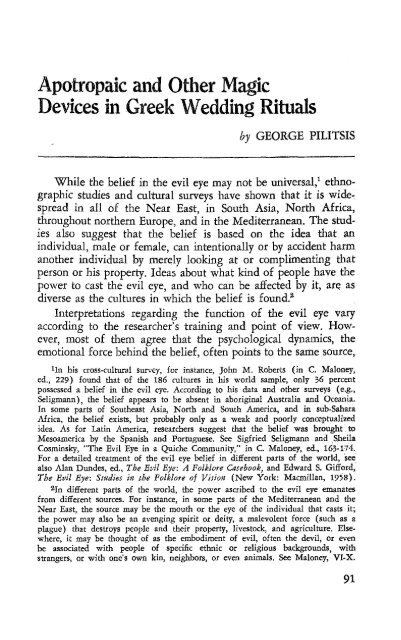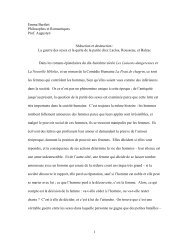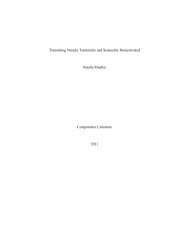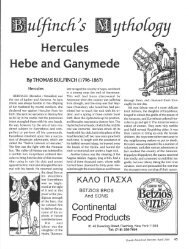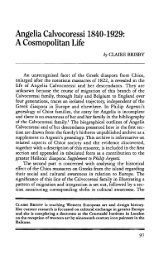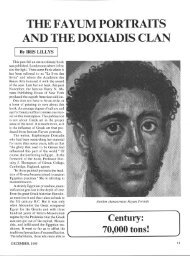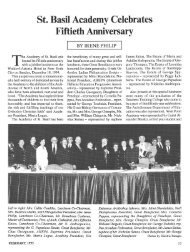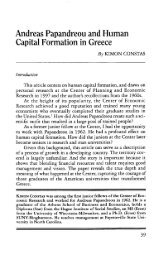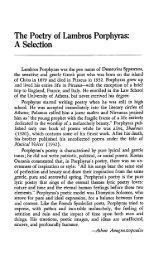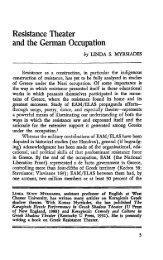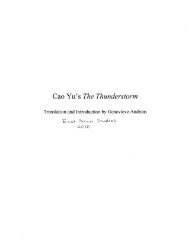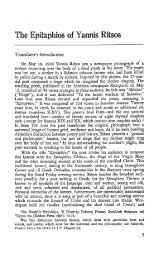Apotropaic and Other Magic Devices in Greek ... - Triceratops Home
Apotropaic and Other Magic Devices in Greek ... - Triceratops Home
Apotropaic and Other Magic Devices in Greek ... - Triceratops Home
You also want an ePaper? Increase the reach of your titles
YUMPU automatically turns print PDFs into web optimized ePapers that Google loves.
<strong>Apotropaic</strong> <strong>and</strong> <strong>Other</strong> <strong>Magic</strong><br />
<strong>Devices</strong> <strong>in</strong> <strong>Greek</strong> Wedd<strong>in</strong>g Rituals<br />
by GEORGE PILITSIS<br />
While the belief <strong>in</strong> the evil eye may not be universal,' ethnographic<br />
studies <strong>and</strong> cultural surveys have shown that it is widespread<br />
<strong>in</strong> all of the Near East, <strong>in</strong> South Asia, North Africa,<br />
throughout northern Europe, <strong>and</strong> <strong>in</strong> the Mediterranean. The studies<br />
also suggest that the belief is based on the idea that an<br />
<strong>in</strong>dividual, male or female, can <strong>in</strong>tentionally or by accident harm<br />
another <strong>in</strong>dividual by merely look<strong>in</strong>g at or compliment<strong>in</strong>g that<br />
person or his property. Ideas about what k<strong>in</strong>d of people have the<br />
power to cast the evil eye, <strong>and</strong> who can be affected by it, are as<br />
diverse as the cultures <strong>in</strong> which the belief is found.'<br />
Interpretations regard<strong>in</strong>g the function of the evil eye vary<br />
accord<strong>in</strong>g to the researcher's tra<strong>in</strong><strong>in</strong>g <strong>and</strong> po<strong>in</strong>t of view. However,<br />
most of them agree that the psychological dynamics, the<br />
emotional force beh<strong>in</strong>d the belief, often po<strong>in</strong>ts to the same source,<br />
I-In his cross-cultural survey, for <strong>in</strong>stance, John M. Roberts (<strong>in</strong> C. Maloney,<br />
ed., 229) found that of the 186 cultures <strong>in</strong> his world sample, only 36 percent<br />
possessed a belief <strong>in</strong> the evil eye. Accord<strong>in</strong>g to his data <strong>and</strong> other surveys (e.g.,<br />
Seligmann), the belief appears to be absent <strong>in</strong> aborig<strong>in</strong>al Australia <strong>and</strong> Oceania.<br />
In some parts of Southeast Asia, North <strong>and</strong> South America, <strong>and</strong> <strong>in</strong> sub-Sahara<br />
Africa, the belief exists, but probably only as a weak <strong>and</strong> poorly conceptualized<br />
idea. As for Lat<strong>in</strong> America, researchers suggest that the belief was brought to<br />
Mesoamerica by the Spanish <strong>and</strong> Portuguese. See Sigfried Seligmann <strong>and</strong> Sheila<br />
Cosm<strong>in</strong>aky, "The Evil Eye <strong>in</strong> a Quiche Community," <strong>in</strong> C. Maloney, ed., 163-174.<br />
For a detailed treatment of the evil eye belief <strong>in</strong> different parts of the world, see<br />
also Alan Dundes, ed., The Evil Eye: A Folklore Casebook, <strong>and</strong> Edward S. Gifford,<br />
The Evil Eye: Studies <strong>in</strong> the Folklore of Vision (New York: Macmillan, 1958).<br />
2In different parts of the world, the power ascribed to the evil eye emanates<br />
from different sources. For <strong>in</strong>stance, <strong>in</strong> some parts of the Mediterranean <strong>and</strong> the<br />
Near East, the source may be the mouth or the eye of the <strong>in</strong>dividual that casts it;<br />
the power may also be an aveng<strong>in</strong>g spirit or deity, a malevolent force (such as a<br />
plague) that destroys people <strong>and</strong> their property, livestock, <strong>and</strong> agriculture. Elsewhere,<br />
it may be thought of as the embodiment of evil, often the devil, or even<br />
be associated with people of specific ethnic or religious backgrounds, with<br />
strangers, or with one's own k<strong>in</strong>, neighbors, or even animals. See Maloney, VI-X.<br />
91
92 JOURNAL OF THE HELLENIC DIASPORA<br />
the same emotion: the fear of be<strong>in</strong>g envied. This emotion appears<br />
to be a common factor <strong>in</strong> almost all those societies that possess<br />
the belief <strong>in</strong> the evil eye (Roberts, 261). Furthermore, gossip<br />
<strong>and</strong> magic have often been associated with the evil eye, <strong>and</strong> have<br />
been dealt with as manifestations of envy . 3<br />
In Greece, the belief <strong>in</strong> the evil eye appears to be fairly consistent<br />
<strong>and</strong> uniform <strong>and</strong> is often associated with envy, gossip,<br />
<strong>and</strong> magic.4 While anyone, young or old, male or female, ugly<br />
or beautiful, may <strong>in</strong>vite or provoke envy <strong>and</strong> thus become a victim<br />
of the evil eye, gossip, <strong>and</strong> aggressive magic, it is usually the<br />
fortunate, the prosperous, <strong>and</strong> those <strong>in</strong> a period of transition <strong>in</strong><br />
life that run the greatest risk of fall<strong>in</strong>g prey to its effects. These<br />
<strong>in</strong>clude young children; mothers at the time of childbirth <strong>and</strong> until<br />
their purification, forty days after the birth; <strong>and</strong> young people<br />
dur<strong>in</strong>g the time of courtship <strong>and</strong>, especially, at the time of their<br />
wedd<strong>in</strong>g. Accord<strong>in</strong>g to popular belief, the physical harm caused<br />
by the evil eye <strong>and</strong> aggressive magic can range from illness to<br />
death. A person afflicted with it may experience symptoms rang<strong>in</strong>g<br />
from severe headaches, loss of appetite, vomit<strong>in</strong>g, fever, <strong>and</strong><br />
sleep<strong>in</strong>ess, to irritation or depression. Moreover, misfortunes <strong>in</strong><br />
one's life, such as loss of wealth or employment, destruction<br />
of property, or wrecked marriage, are often attributed to the<br />
8In his discussion of the function of the evil eye belief complex <strong>in</strong> the Middle<br />
East, B. Spooner (Maloney, ed., 79) states: "The concept of the evil eye appears<br />
to be an <strong>in</strong>stitutionalized psychological idiom for the personalization, or simply<br />
the personification of misfortune, <strong>in</strong> particular <strong>in</strong>sofar as misfortune, or fear of it,<br />
may relate to the fear of outsiders <strong>and</strong> their envy." George Foster <strong>and</strong> Eric R. Wolf<br />
also deal with the evil eye, gossip <strong>and</strong> magic as manifestations of envy. In their<br />
view, however, <strong>in</strong>stitutionalized envy functions not as a means to expla<strong>in</strong> or<br />
rationalize all types of sickness, misfortunes, or loss of possessions such as animals<br />
<strong>and</strong> crops, as Spooner <strong>and</strong> others have suggested, but rather as a means of social<br />
control, m<strong>in</strong>imiz<strong>in</strong>g deviant behavior. G. Foster, "Peasant Society <strong>and</strong> the Image<br />
of Limited Good," American Anthropologist 67 (1965), 293-315; Eric R. Wolf,<br />
"Types of Lat<strong>in</strong> American Peasantry: A Prelim<strong>in</strong>ary Discussion," American<br />
Anthropologist 57 (1955), 452-71; see also, Paul R. Turner, "Witchcraft as<br />
Negative Charisma," Ethnology 9 (1970), 366-72. For various other <strong>in</strong>terpretations<br />
regard<strong>in</strong>g the function of aggressive magic <strong>and</strong> the evil eye, see C. Maloney.<br />
4For accounts of the evil eye <strong>in</strong> modern Greece, see Reg<strong>in</strong>a Dionisopoulos-Mass;<br />
J. K. Gubb<strong>in</strong>s, "Some Observations on the Evil Eye <strong>in</strong> Modern Greece," Folklore<br />
57 (1946) 195-197; Robert A. Georges, "Matiasma: Liv<strong>in</strong>g Folk Belief," Midwest<br />
Folklore 12 (1962) 69-74; Margaret M. Hardie, "The Evil Eye <strong>in</strong> Some Villages<br />
of the Upper Haliakmon Valley <strong>in</strong> West Macedonia," <strong>in</strong> Alan Dundes, ed., 107-<br />
123; see also, John C. Lawson, Modern <strong>Greek</strong> Folklore <strong>and</strong> Ancient <strong>Greek</strong> Religion<br />
(Cambridge University Press, 1910); G. F. Abbott; Richard Blum <strong>and</strong> Eva Blum,
<strong>Apotropaic</strong> <strong>Devices</strong> <strong>in</strong> <strong>Greek</strong> Wedd<strong>in</strong>g Rituals 93<br />
malevolent power of the evil eye <strong>and</strong> magic.<br />
Marriage is a time when tension <strong>and</strong> anxiety run high. This<br />
is a period <strong>in</strong> the life cycle which presents the greatest danger<br />
<strong>and</strong> thus is a time when the <strong>in</strong>dividual feels exposed to great<br />
risks emanat<strong>in</strong>g from the world of magic <strong>and</strong> the supernatural.<br />
In his discussion of the effects of the evil eye, Schoeck said: "All<br />
objects <strong>and</strong> action surround<strong>in</strong>g marriage <strong>and</strong> birth <strong>in</strong>vite the<br />
evil eye: the marriage bed, wedd<strong>in</strong>g gifts, <strong>and</strong> the consummation<br />
of marriage." 5 It has long been recognized that to feel exposed<br />
to risk is to feel vulnerable. Therefore, vulnerability can be viewed<br />
as one of the key concepts which is associated with magic <strong>and</strong> the<br />
evil eye belief complex. In light of this, we may suggest that the<br />
ultimate goal of various rites <strong>and</strong> rituals observed at the time of<br />
marriage is not only to effect a smooth passage for the <strong>in</strong>dividuals,<br />
eas<strong>in</strong>g their transition from one stage to another, as Arnold van<br />
Gennep6 has shown, but also to protect them aga<strong>in</strong>st possible<br />
attacks of aggressive magic. Furthermore, the rites may also be<br />
viewed as ways of m<strong>in</strong>imiz<strong>in</strong>g the effects of envy manifested <strong>in</strong><br />
the evil eye, which may consciously or unconsciously be cast upon<br />
the bride or groom.<br />
I will limit this article to discuss<strong>in</strong>g the apotropaic function of<br />
a number of customs <strong>and</strong> rites observed <strong>in</strong> various parts of Greece<br />
before <strong>and</strong> dur<strong>in</strong>g the wedd<strong>in</strong>g ceremony. I will also deal with<br />
prophylactic spells <strong>and</strong> other methods used to defend the couple<br />
aga<strong>in</strong>st the harmful effects of magic, the evil eye, <strong>and</strong> gossip.<br />
The examples chosen come from the wealth of material conta<strong>in</strong>ed<br />
<strong>in</strong> ethnographic studies <strong>and</strong> collections of <strong>Greek</strong> folklore, as well<br />
as from personal observations <strong>and</strong> <strong>in</strong>quiries. The customs that<br />
will be discussed here are, I th<strong>in</strong>k, fairly representative, <strong>and</strong> many<br />
of them are preserved <strong>in</strong> various ways <strong>in</strong> villages <strong>and</strong> towns<br />
throughout Greece. But, of course, this is only a small sample<br />
of the rich variety of prophylactic rites that accompany <strong>Greek</strong><br />
wedd<strong>in</strong>gs.<br />
Marriage is a joyful celebration of life. A newly engaged<br />
couple or newlyweds are required <strong>and</strong> often advised to be especially<br />
careful <strong>and</strong> guarded aga<strong>in</strong>st envious barren women, child-<br />
5Helmut Schoek, "The Evil Eye: Forms <strong>and</strong> Dynamics of Universal Superstition,"<br />
<strong>in</strong> Alan Dundes, ed., 196.<br />
°Arnold Van Gennep, The Rites of Passage (London, 1960).
94 JOURNAL OF THE HELLENIC DIASPORA<br />
less widows, jealous suitors <strong>and</strong> disappo<strong>in</strong>ted lovers, or mothers<br />
of unmarried daughters <strong>and</strong> sons. Any of these people are regarded<br />
as potential enemies because they could, from envy, spread<br />
malicious rumors about the reputation of the couple with the<br />
<strong>in</strong>tention of break<strong>in</strong>g their engagement or ru<strong>in</strong><strong>in</strong>g their marriage.<br />
The more aggressive ones could cast the evil eye or resort to<br />
magic <strong>and</strong> seriously harm the couple.<br />
While morals <strong>and</strong> customs change to fit contemporary attitudes<br />
<strong>and</strong> values, <strong>in</strong> rural areas of Greece, where people cont<strong>in</strong>ue<br />
to observe traditional lifestyles, a number of marriages are still<br />
arranged, usually through the negotiations of a proxenitis or<br />
proxenitra (marriage <strong>in</strong>termediary) . This person may be a friend,<br />
a relative, or a professional matchmaker, generally a woman.<br />
Accord<strong>in</strong>g to several reports, the reputation of the prospective<br />
couple <strong>and</strong> their families <strong>in</strong> the community contributes greatly to<br />
the success of the arrangement. In a village or small town, where<br />
one's actions are easily observed by neighbors <strong>and</strong> where privacy<br />
is virtually unknown, that reputation could easily be ru<strong>in</strong>ed<br />
through the malevolent force of gossip.<br />
Everyone <strong>in</strong> the village is aware of the power of koutsobolio<br />
(gossip) <strong>and</strong> its effects on people. Those who participate <strong>in</strong> it<br />
with the <strong>in</strong>tent of us<strong>in</strong>g it maliciously are often referred to as<br />
glossophagoi, gossipmongers, who devour with their tongues.<br />
They . . . are feared for their aggressive <strong>and</strong> malicious<br />
natures <strong>and</strong> abilities. These are people who can cause<br />
great harm by employ<strong>in</strong>g their powers directly. They speak,<br />
thus caus<strong>in</strong>g envy <strong>and</strong> jealousy to arise. They are people<br />
who sl<strong>and</strong>er others, start<strong>in</strong>g stories about one's reputation<br />
<strong>and</strong> actions with the <strong>in</strong>tention of do<strong>in</strong>g harm.'<br />
Moreover, aggressive gossipers are often believed to use magic<br />
with their threats, <strong>and</strong>, s<strong>in</strong>ce they speak with the <strong>in</strong>tent to do<br />
harm, one must always be on guard <strong>and</strong> do everyth<strong>in</strong>g possible<br />
to protect him/herself from them. In their discussion of the function<br />
of gossip <strong>in</strong> <strong>Greek</strong> village society, Richard Blum <strong>and</strong> Eva<br />
Blum state:<br />
Dionisopoulos-Mass <strong>in</strong> Clarence Maloney, ed., 53.
<strong>Apotropaic</strong> <strong>Devices</strong> <strong>in</strong> <strong>Greek</strong> Wedd<strong>in</strong>g Rituals 95<br />
The less ritualized <strong>and</strong> more socially dynamic use of words<br />
<strong>in</strong> village gossip is considered to be a source of danger,<br />
not just to reputation <strong>and</strong> social position, but to health<br />
itself. In talk<strong>in</strong>g to the villagers, one ga<strong>in</strong>s the impression<br />
that gossip may be conceived as act<strong>in</strong>g directly. The words<br />
themselves do harm <strong>in</strong>dependently of the destructive social<br />
effects they may have <strong>and</strong> <strong>in</strong>dependently of the motives of<br />
malice, envy <strong>and</strong> anger which gossip reflects <strong>in</strong> the speaker;<br />
motives which might well be expressed <strong>in</strong> conduct damag<strong>in</strong>g<br />
to the victim of these feel<strong>in</strong>gs. In this sense, gossip<br />
may be viewed by the observer as a triple threat: the words<br />
harm magically by themselves, they also do damage <strong>in</strong>sofar .<br />
as they are believed to produce social damage, <strong>and</strong>, f<strong>in</strong>ally,<br />
the motives reflected <strong>in</strong> gossip may also move the gossip<strong>in</strong>g<br />
person to do sorcery or to engage <strong>in</strong> other destructive<br />
acts.'<br />
At times of marriage, one way for <strong>in</strong>dividuals to protect<br />
themselves aga<strong>in</strong>st any potential harm malicious gossip may cause<br />
is to conduct the marriage negotiations <strong>in</strong> absolute secrecy. The<br />
parents of the young man <strong>and</strong> the girl, as well as the matchmaker,<br />
therefore take precautions not to reveal or discuss the matter<br />
with outsiders until it becomes official. Their fear stems from<br />
the possibility that malicious gossip may arouse jealousy <strong>in</strong> people<br />
who, from envy, may attempt to prevent the arrangement from<br />
be<strong>in</strong>g fulfilled. This can be done either by cast<strong>in</strong>g spells or the<br />
evil eye, or by employ<strong>in</strong>g various methods of aggressive magic<br />
on the young couple with the <strong>in</strong>tention of mak<strong>in</strong>g them lose<br />
<strong>in</strong>terest <strong>in</strong> each other. One such method, revealed to me by a<br />
woman from Serres now liv<strong>in</strong>g <strong>in</strong> the United States, <strong>in</strong>volves the<br />
use of oil from the oilwick c<strong>and</strong>les that burn on graves. The oil<br />
is mixed with the blood of a menstruat<strong>in</strong>g woman. If the target<br />
were a young man, the aggressor would spr<strong>in</strong>kle some of this<br />
mixture on the unsuspect<strong>in</strong>g man or on the door of the girl's house.<br />
The effects are believed to be irreversible. From various <strong>in</strong>quiries,<br />
this appears to be a well-known magic recipe for scorned lovers<br />
<strong>in</strong> many parts of Greece. In view of this, one can easily appreciate<br />
8For various examples regard<strong>in</strong>g the effects of gossip <strong>and</strong> its association with<br />
magic, see especially 15, 168-70.
96 JOURNAL OF THE HELLENIC DIASPORA<br />
the fear <strong>and</strong> concerns of the parents <strong>in</strong> keep<strong>in</strong>g the matter of<br />
wedd<strong>in</strong>g negotiations secret.<br />
The time dur<strong>in</strong>g which the negotiations are conducted is also<br />
critical. A skillful <strong>and</strong> experienced matchmaker, if she acts as a<br />
matrimonial agent for the young man, would carry the marriage<br />
proposal to the girl's parents at night. This lessens the chance<br />
of be<strong>in</strong>g seen by curious neighbors, who, suspect<strong>in</strong>g the purpose<br />
of her visit, might beg<strong>in</strong> to gossip <strong>and</strong>, from envy or spite, spread<br />
untruthful stories about the girl with the malicious <strong>in</strong>tention of<br />
foil<strong>in</strong>g the match. Dur<strong>in</strong>g the negotiations, apotropaic spells <strong>and</strong><br />
rituals may also be used to further defend the matchmak<strong>in</strong>g <strong>and</strong><br />
those directly <strong>in</strong>volved. In her discussion of the betrothal arrangements<br />
<strong>in</strong> the isl<strong>and</strong> of Imbros, for <strong>in</strong>stance, Bakaemi (507) states<br />
that, dur<strong>in</strong>g the <strong>in</strong>formal negotiations, the matchmaker would<br />
propose on behalf of the young man <strong>and</strong> his family <strong>and</strong> then,<br />
address<strong>in</strong>g herself to the girl's mother, she adds the customary<br />
phrase, "vali skoupa kai farash proxenia na mi halash," that is,<br />
"br<strong>in</strong>g out the broom <strong>and</strong> the dustpan so that the matchmak<strong>in</strong>g<br />
would not break." While the expression is not to be taken<br />
literally, it may be regarded as a magic spell <strong>in</strong> the sense that the<br />
broom <strong>and</strong> the dustpan, two common household items, are <strong>in</strong>vested<br />
with symbolic magic qualities. Act<strong>in</strong>g on the pr<strong>in</strong>ciple of homeopathic<br />
magic, they would sweep away malicious gossip <strong>and</strong> its<br />
evil <strong>in</strong>tentions on the matchmak<strong>in</strong>g.<br />
Eager to succeed <strong>in</strong> arrang<strong>in</strong>g a suitable match, the matchmaker<br />
would praise the couple, often extoll<strong>in</strong>g his or her qualities,<br />
attributes, <strong>and</strong> virtues, as well as their wealth <strong>and</strong> health. By<br />
do<strong>in</strong>g so, however, she un<strong>in</strong>tentionally exposes them to the dangers<br />
of envy <strong>and</strong> the evil eye, To counteract any potential harm<br />
that her excessive praise might br<strong>in</strong>g <strong>and</strong> to ward off the dreaded<br />
evil, the matchmaker often <strong>in</strong>terjects various spells which are<br />
usually accompanied by ritual acts. For <strong>in</strong>stance, she would make<br />
the sign of the cross <strong>and</strong> recite, "may the evil eye not fall on<br />
him [or her)." Here the sign of the cross makes a direct appeal<br />
to religion for protection. By acknowledg<strong>in</strong>g a higher power as<br />
a protector, the danger of fasc<strong>in</strong>ation, or matiasma, is averted.<br />
aFor the dangers of praise <strong>and</strong> its association with the evil eye belief <strong>in</strong><br />
different parts of the world, see Eugene S. McCartney, "Praise <strong>and</strong> Dispraise <strong>in</strong><br />
Folklore," <strong>in</strong> Alan Dundes, ed., 9-38.
<strong>Apotropaic</strong> <strong>Devices</strong> <strong>in</strong> <strong>Greek</strong> Wedd<strong>in</strong>g Rituals 97<br />
At other times, she would toss p<strong>in</strong>ches of salt <strong>in</strong>to the fire <strong>and</strong><br />
say: "May the evil eye <strong>and</strong> jealousy burst as this salt bursts," or<br />
she would make a symbolic gesture of cast<strong>in</strong>g her words of praise<br />
from her mouth <strong>in</strong>to the fire <strong>in</strong> the hope that the flames would<br />
consume her words <strong>and</strong> thus elim<strong>in</strong>ate any potential danger they<br />
might pose to the <strong>in</strong>dividual praised.<br />
When the prelim<strong>in</strong>ary negotiations are completed, <strong>and</strong> some<br />
agreement with regard to the terms, nature, <strong>and</strong> amount of the<br />
girl's dowry is reached by both parties, the preparations for the<br />
formal engagement (arravonas) get under way. Tak<strong>in</strong>g the necessary<br />
precautions not to be seen by anybody <strong>in</strong> the streets, the<br />
groom, his parents, a few of his very close relatives, <strong>and</strong> the<br />
marriage negotiator arrive at the girl's house late one even<strong>in</strong>g.<br />
A Saturday or Sunday night is preferred, while Monday <strong>and</strong><br />
Tuesday even<strong>in</strong>gs are avoided at all cost (they are regarded as<br />
the most unpropitious days to conduct the ceremony, for fear that<br />
the couple will divorce <strong>and</strong> remarry a second or even a third<br />
time—defterosi or tritosi). Evidently, the names deftera (second)<br />
for Monday <strong>and</strong> triti (third) for Tuesday gave rise to this belief.<br />
The engagement usually consists of two stages: the sign<strong>in</strong>g<br />
of the dowry agreement (proikosimfono)," <strong>and</strong> the exchange of<br />
the r<strong>in</strong>gs (veres). In the first part, the men go over the dowry one<br />
last time, <strong>and</strong> if everyth<strong>in</strong>g is accord<strong>in</strong>g to their agreement, the<br />
bride's father signs the proikosimf ono <strong>in</strong> the presence of three<br />
witnesses. Elsewhere <strong>in</strong> Greece, this may be done on the next<br />
day <strong>in</strong> the local municipal build<strong>in</strong>g <strong>and</strong> before a public officer,<br />
who also acts as a notary. The second part of the ceremony focuses<br />
on the ritual exchange of the r<strong>in</strong>gs. The details may vary from<br />
region to region <strong>and</strong> accord<strong>in</strong>g to local <strong>and</strong> family traditions.<br />
For <strong>in</strong>stance, <strong>in</strong> his report on the wedd<strong>in</strong>g customs <strong>in</strong> the district<br />
of Grevena, Karapatakis (26) states that, until recently, it was<br />
customary for mothers of prospective spouses to prepare the<br />
101n contrast to her trousseau, the bride's dowry usually consists of real estate,<br />
such as arable l<strong>and</strong>, v<strong>in</strong>eyards, olive orchards, commercial lots, <strong>and</strong> a house or<br />
apartment, as well as animals <strong>and</strong> cash. For a more detailed discussion on the<br />
<strong>in</strong>stitution of the dowry, its function <strong>and</strong> symbolism <strong>in</strong> the life of women <strong>in</strong> <strong>Greek</strong><br />
rural society, as well as the changes <strong>in</strong> recent years, see Juliet du Boulay, "The<br />
Mean<strong>in</strong>g of Dowry: Chang<strong>in</strong>g Values <strong>in</strong> Rural Greece," Journal of Modern <strong>Greek</strong><br />
Studies 1 (May 1983) 243-270; cf. Ernest<strong>in</strong>e Friedle, Vasilika: A Village <strong>in</strong><br />
Modern Greece (New York, 1962), <strong>and</strong> -Dowry <strong>and</strong> Inheritance <strong>in</strong> Modern<br />
Greece," Transactions of the New York Academy of Sciences, 22:49-54.
98 JOURNAL OF THE HELLENIC DIASPORA<br />
r<strong>in</strong>gs for their children. They bound gold r<strong>in</strong>gs with a piece of<br />
red silk thread around a small bunch of dry basil with roots. The<br />
silk thread <strong>and</strong> the roots, symboliz<strong>in</strong>g strength <strong>and</strong> stability, were<br />
supposed to extend their qualities to marriage. They tied cotton<br />
<strong>and</strong> red-dyed wool to the dried basil. At the appropriate time,<br />
the mothers place the r<strong>in</strong>gs on a table next to a cross or on an<br />
icon taken down from the family shr<strong>in</strong>e (iconostasi).<br />
It is <strong>in</strong>terest<strong>in</strong>g to note that this custom bears a strik<strong>in</strong>g<br />
similarity to rituals of supplication <strong>and</strong> appeasement observed <strong>in</strong><br />
preChristian Greece. In antiquity, branches taken from an olive<br />
tree <strong>and</strong> draped with some wool were presented to a div<strong>in</strong>ity or<br />
to a person of high authority <strong>and</strong> power, <strong>in</strong> exchange for the<br />
suppliant's safety <strong>and</strong> protection. It is likely that the modern<br />
<strong>Greek</strong> custom observed at Grevena on the engagement night functions<br />
on the same pr<strong>in</strong>ciple. Act<strong>in</strong>g as suppliants for their children,<br />
the mothers place the union, symbolized by the r<strong>in</strong>gs, under<br />
the direct protection <strong>and</strong> safety of the church <strong>and</strong> religion represented<br />
by the cross <strong>and</strong> the icon. The twigs of basil used <strong>in</strong> the<br />
ritual may also be regarded as a means to further the protection.<br />
In <strong>Greek</strong> tradition, basil is often associated with rituals of purification<br />
<strong>and</strong> protection observed at home <strong>and</strong> by the church. For<br />
<strong>in</strong>stance, <strong>in</strong> a effort to keep evil spirits away, the priest uses<br />
branches of dry or fresh basil to spr<strong>in</strong>kle holy water on people<br />
<strong>and</strong> their homes, as well as on livestock <strong>and</strong> crops <strong>in</strong> the fields."<br />
Similarly, home recipes for protection aga<strong>in</strong>st the evil eye <strong>and</strong><br />
magic often call for the use of basil leaves. Interest<strong>in</strong>gly enough,<br />
<strong>in</strong> several wedd<strong>in</strong>g songs from various parts of Greece the bride<br />
<strong>and</strong> groom often referred to as sweet basil, as <strong>in</strong> the follow<strong>in</strong>g<br />
songs from Thassos, quoted by Abbott (175) <strong>and</strong> from Serres.<br />
1. The bridegroom is basil <strong>and</strong> our bride is c<strong>in</strong>namon<br />
The bridegroom is basil <strong>and</strong> our bride sweet marjoram . • .<br />
2. Bridegroom take care of our bride, our sweet basil<br />
Her fragrance is known to the East <strong>and</strong> West .. .<br />
11The qualities with which the plant is <strong>in</strong>vested may be due to its association<br />
with the Holy Cross. It is alleged that, <strong>in</strong> search for the cross on which Christ<br />
died <strong>in</strong> Golgotha, the Emperor Constant<strong>in</strong>e <strong>and</strong> his mother Helena came upon a
<strong>Apotropaic</strong> <strong>Devices</strong> <strong>in</strong> <strong>Greek</strong> Wedd<strong>in</strong>g Rituals 99<br />
Later that even<strong>in</strong>g the fathers of the prospective couple would<br />
exchange the r<strong>in</strong>gs by plac<strong>in</strong>g them <strong>in</strong> each other's h<strong>and</strong> three<br />
times. After the exchange, the groom's father would place the<br />
r<strong>in</strong>g on the f<strong>in</strong>ger of the bride's left h<strong>and</strong>, while the bride's<br />
father would place the r<strong>in</strong>g on the f<strong>in</strong>ger of the groom's left<br />
h<strong>and</strong>. The ritual would conclude with the couple kiss<strong>in</strong>g everyone's<br />
h<strong>and</strong>, while they, <strong>in</strong> their turn, would present the couple<br />
with various gifts.<br />
The engagement ceremony thus completed marks the beg<strong>in</strong>n<strong>in</strong>g<br />
of an open relationship between the two <strong>in</strong>dividuals, while<br />
mak<strong>in</strong>g the agreement between the two families official. On the<br />
days that follow, friends <strong>and</strong> relatives visit the girl at her home<br />
to congratulate <strong>and</strong> praise her good fortune <strong>in</strong> f<strong>in</strong>d<strong>in</strong>g a husb<strong>and</strong>.<br />
Aware of the danger such praises may conceal, however, the <strong>in</strong>dividual<br />
is required to take certa<strong>in</strong> precautions. For <strong>in</strong>stance, on<br />
the isl<strong>and</strong> of Lesbos, the mother of the girl sweeps the floor or<br />
throws ashes or salt outside the ma<strong>in</strong> entrance after the wellwishers<br />
leave the house (Zourou, 111). The symbolism beh<strong>in</strong>d<br />
such a ritual act is that the potentially harmful praises would be<br />
swept away from the house <strong>and</strong>, by extension, from the daughter,<br />
or that they would melt like the salt or scatter <strong>in</strong> the w<strong>in</strong>d like<br />
ashes. Here, too, the ritual is apparently based on the pr<strong>in</strong>ciple<br />
of homeopathic magic.<br />
Generally, wedd<strong>in</strong>gs require careful plann<strong>in</strong>g, <strong>and</strong> <strong>in</strong> Greece,<br />
depend<strong>in</strong>g on the region, the preparations may last for an- entire<br />
week. On each day special activities are held <strong>and</strong> various customs<br />
are observed, often with the direct participation of relatives,<br />
friends, <strong>and</strong> neighbors. While many of these activities are filled<br />
with joy <strong>and</strong> playfulness appropriate for the occasion, there are<br />
others that reflect tension <strong>and</strong> anxiety, especially on the part of<br />
the bride <strong>and</strong> her mother. Such feel<strong>in</strong>gs often stem from fear<br />
<strong>and</strong> a real concern over the possibility that such a happy occasion<br />
might provoke envy <strong>and</strong> feel<strong>in</strong>gs of jealousy <strong>in</strong> less fortunate<br />
people. Therefore, a number of rites may be <strong>in</strong>terpreted as<br />
prophylactic measures aga<strong>in</strong>st the effects of the evil eye, b<strong>in</strong>d<strong>in</strong>g<br />
spells, <strong>and</strong> other forms of aggressive magic.<br />
mount on which a basil plant grew. Overwhelmed by its sweet fragrance <strong>and</strong><br />
believ<strong>in</strong>g it to be a god-sent sign, the Empress ordered the excavation of the site.<br />
The cross found buried there she declared to be the "true cross" of Christ.
100 JOURNAL OF THE HELLENIC DIASPORA<br />
In some villages <strong>and</strong> small towns it is still customary a few<br />
days before the wedd<strong>in</strong>g for the bride, with the help of her<br />
mother <strong>and</strong> other female relatives <strong>and</strong> friends, to display her<br />
proika,'2 or trousseau, at her house. The time <strong>and</strong> manner vary<br />
from region to region, <strong>and</strong> the amount of her proika also varies,<br />
depend<strong>in</strong>g on her social <strong>and</strong> economic status. It usually consists<br />
of a mattress for the bridal bed, <strong>and</strong> items such as l<strong>in</strong>ens, blankets,<br />
embroidered tablecloths, couch covers, <strong>and</strong> rugs. Previously, all<br />
of these items were h<strong>and</strong>made by the bride <strong>and</strong> her mother <strong>and</strong><br />
were accumulated over the years, though, given the economic<br />
growth <strong>and</strong> mobility <strong>in</strong> Greece <strong>in</strong> recent years, most of these<br />
items are now bought from stores. <strong>Other</strong> articles <strong>in</strong>clude personal<br />
cloth<strong>in</strong>g, such as l<strong>in</strong>gerie, dresses, overcoats, <strong>and</strong> shoes, as well<br />
as household items <strong>and</strong> kitchen utensils. Everyth<strong>in</strong>g is arranged<br />
<strong>in</strong> a conpicuous place <strong>in</strong>side the house so that the number of<br />
articles <strong>and</strong> their value can easily be seen <strong>and</strong> appreciated. Such a<br />
conscious exhibition of the prosperity <strong>and</strong> labor, however, could<br />
provoke the envy of neighbors who come to <strong>in</strong>spect <strong>and</strong> admire<br />
the dowry.<br />
S<strong>in</strong>ce the evil eye is believed to <strong>in</strong>discrim<strong>in</strong>ately attack people<br />
as well as their property, an anxious bride or her mother often<br />
resorts to various prophylactic measures. Some of these <strong>in</strong>clude<br />
the use of amulets <strong>and</strong> charms. Traditionally, blue charms are<br />
believed to be the most effective aga<strong>in</strong>st evil eye attacks. Thus,<br />
<strong>in</strong> the rooms where the bride's trousseau is displayed, blue beads,<br />
strung with silver or golden threads, <strong>and</strong> blue ribbons are often<br />
seen hang<strong>in</strong>g conspicuously from the walls or furniture. <strong>Other</strong><br />
objects may <strong>in</strong>clude small icons or wooden crosses; their direct<br />
association with religion re<strong>in</strong>forces their efficacy as apotropaic<br />
amulets.<br />
It is believed that, as a symbol of marriage <strong>and</strong> conjugal union,<br />
the wedd<strong>in</strong>g mattress often becomes an object of envy <strong>and</strong> arouses<br />
feel<strong>in</strong>gs of jealousy <strong>in</strong> those who come to admire the dowry.<br />
Protective measures, therefore, are taken before the mattress is<br />
displayed. For <strong>in</strong>stance, <strong>in</strong> the village of Arahova, near Delphi,<br />
<strong>and</strong> on the isl<strong>and</strong> of Lefkas <strong>in</strong> the Ionian Sea, the bride's mother<br />
or a very close relative puts bay or myrtle leaves, dried nuts <strong>and</strong><br />
rais<strong>in</strong>s, rice, salt, a silver co<strong>in</strong> or a small r<strong>in</strong>g-shaped bread <strong>in</strong>side<br />
121n <strong>Greek</strong>, the term proika applies to both the dowry <strong>and</strong> the trousseau.
<strong>Apotropaic</strong> <strong>Devices</strong> <strong>in</strong> <strong>Greek</strong> Wedd<strong>in</strong>g Rituals 101<br />
the mattress before she sews the mattress with pieces of blue <strong>and</strong><br />
red thread. In another room of the house, female relatives <strong>and</strong><br />
close friends make various noises by bang<strong>in</strong>g on bronze utensils<br />
while s<strong>in</strong>g<strong>in</strong>g various prenuptial songs. The noise is supposed to<br />
keep the evil spirits away or to divert their attention from the<br />
ritual. After the mattress has been p<strong>in</strong>ned, the women choose a<br />
male child, preferably a relative of the bride <strong>and</strong> one whose<br />
parents are both alive, <strong>and</strong> <strong>in</strong>struct him to sit or roll on the mattress<br />
"for good luck," so that "the first child born to the bride<br />
would be male." Evidently, this type of homeopathic magic is<br />
common at wedd<strong>in</strong>gs throughout Greece."<br />
The prophylactic amulets sewn <strong>in</strong>to the mattress also function<br />
as fertility-promot<strong>in</strong>g charms. They are supposed to protect the<br />
bride <strong>and</strong> groom on their wedd<strong>in</strong>g night <strong>and</strong> to ensure a successful<br />
consummation of their marriage. Elsewhere <strong>in</strong> Greece, additional<br />
measures to protect the dowry from the evil eye <strong>and</strong><br />
aggressive magic are taken at the bride's home. Informants from<br />
the villages of Nigrita, Neo Souli, Porroya, <strong>and</strong> Lebadea <strong>in</strong><br />
central Macedonia have reported that before <strong>and</strong> after the display<br />
or apolma tis proikas, the dowry l<strong>in</strong>ens are kept <strong>in</strong> chests or trunks<br />
with various blue charms. C<strong>and</strong>le stubs from the Easter services<br />
<strong>and</strong> christoloulouda (flowers from the replica of the tomb of<br />
Christ used <strong>in</strong> Good Friday services) are also placed <strong>in</strong> the<br />
trunks by some families. On some Aegean isl<strong>and</strong>s, blue charms<br />
hang from the looms on which dowry articles are woven. They are<br />
designed "to protect both the goods <strong>and</strong> the weaver from the evil<br />
eye" (Dionisopoulos-Mass, 57).<br />
Prophylactic measures aga<strong>in</strong>st possible attacks from the evil<br />
eye were also taken to protect the animals, usually horses <strong>and</strong><br />
donkeys, that carried the dowry to the groom's house. Blue beads<br />
<strong>and</strong> other types of amulets, such as sea shells, woolen tassels, <strong>and</strong><br />
bear or badger hair, were hung from their bridles. On the isl<strong>and</strong><br />
of Lefkas, the men who guided the animals were also protected<br />
by amulets. These were r<strong>in</strong>g-shaped breads, kouloures, which they<br />
hung from their belts. In more recent times, however, automobiles<br />
have become more accessible even <strong>in</strong> small villages. The animals<br />
13For the presence of a male child <strong>in</strong> various stages of the wedd<strong>in</strong>g, see K.<br />
Karapatakis, 99, 114, 121, 129; A. S. Bakaemi, 522; N. T. Hyphantes, 176 n. 8;<br />
G. F. Abbott, 165; Pant. Kontomihis, "0 Lel kaditikos Gams," Epetiris Eterias<br />
Lefkaditikon MeletOn 1 (1971-1972), 115-152.
102 JOURNAL OF THE HELLENIC DIASPORA<br />
that carried the dowry have now been replaced by small pickup<br />
trucks. On the day the dowry is transported, the mother of the<br />
bride may provide the driver with various charms which he<br />
hangs from the rearview mirror of his truck or places on the<br />
dashboard. In addition to the traditional blue beads, the charms<br />
may also <strong>in</strong>clude wool or silk tassels or a small icon of a sa<strong>in</strong>t.<br />
The protective <strong>and</strong> apotropaic qualities of these charms are further<br />
re<strong>in</strong>forced by various prophylactic rituals. In the village of<br />
Nigrita, before the dowry left the house, it was customary for<br />
the bride's mother to spr<strong>in</strong>kle the heads of the animals with<br />
water <strong>and</strong> flour, <strong>and</strong> the goods with rice <strong>and</strong> kouf eta (sugarcoated<br />
nuts, which she had mixed on a plate. Then she made the sign<br />
of the cross <strong>and</strong> broke the plate, while the rest of her relatives<br />
sang wedd<strong>in</strong>g songs appropriate to the occasion. In some village<br />
communities <strong>in</strong> western Macedonia, <strong>in</strong> Crete <strong>and</strong> Epiros, men with<br />
guns used to escort the bride's dowry to the groom's house. The<br />
guns are fired at <strong>in</strong>tervals as the procession moves along the<br />
streets of the village. Act<strong>in</strong>g on the pr<strong>in</strong>ciple of sympathetic magic,<br />
the gunshots are supposed to destroy any evil eye that glanced<br />
at the dowry. Moreover, they are <strong>in</strong>tended to ward off malevolent<br />
spirits which are believed to be envious of human happ<strong>in</strong>ess <strong>and</strong><br />
thus notoriously active at wedd<strong>in</strong>gs.<br />
A set of prelim<strong>in</strong>ary rituals observed before the wedd<strong>in</strong>g<br />
ceremony also <strong>in</strong>cludes the <strong>in</strong>itiation rite of bath<strong>in</strong>g the bride<br />
<strong>and</strong> groom, which is performed on the night before or early <strong>in</strong> the<br />
morn<strong>in</strong>g of the wedd<strong>in</strong>g day. While the ritual once required the<br />
bath<strong>in</strong>g of the entire body, <strong>in</strong> more recent times it has been modified<br />
to wash<strong>in</strong>g the hair only. The ritual is <strong>in</strong>tended not only to<br />
prepare the young couple for the new life they are about to enter<br />
as a husb<strong>and</strong> <strong>and</strong> wife, but also to neutralize the various dangers<br />
associated with sexual contact <strong>and</strong> the evil <strong>in</strong>fluences emanat<strong>in</strong>g<br />
from the world of the supernatural <strong>and</strong> magic. The water for<br />
the bath must be fresh <strong>and</strong> pure. Before <strong>in</strong>door plumb<strong>in</strong>g was<br />
<strong>in</strong>troduced, a common spr<strong>in</strong>g or founta<strong>in</strong> served as the ma<strong>in</strong> supplier<br />
of water for all the people <strong>in</strong> a neighborhood or village. To<br />
avoid meet<strong>in</strong>g any potential enemies of the couple, the water<br />
was fetched at midnight or very early <strong>in</strong> the morn<strong>in</strong>g, preferably<br />
before dawn, lessen<strong>in</strong>g possibility of contact with people. Accord<strong>in</strong>g<br />
to Karapatakis (84-85), <strong>in</strong> the district of Grevena the water
<strong>Apotropaic</strong> <strong>Devices</strong> <strong>in</strong> <strong>Greek</strong> Wedd<strong>in</strong>g Rituals 103<br />
for the groom's bath was fetched from the village spr<strong>in</strong>g a little<br />
after midnight, while the festivities cont<strong>in</strong>ued at his house. The<br />
groom-to-be, with a few of his very close friends, bratimoi, 14<br />
went to the spr<strong>in</strong>g. One bratimos, whose both parents were alive,<br />
fetched the water while the rest of the group sang traditional<br />
water-bear<strong>in</strong>g songs. The water was carried back home <strong>in</strong> a pitcher,<br />
<strong>in</strong> which a twig of sweet basil <strong>and</strong> the groom's wedd<strong>in</strong>g b<strong>and</strong><br />
had been placed. In other villages, follow<strong>in</strong>g local traditions, a<br />
female relative, a boy, or the groom himself fetched the water.<br />
The follow<strong>in</strong>g songs from the Grevena region, cited by Karapatakis,<br />
express the mood of the activity. The first song was sung<br />
on the way to the founta<strong>in</strong>; the second one belongs to the moment<br />
the young man fetched the water.<br />
a. I want to climb a mounta<strong>in</strong><br />
to chisel away the marble<br />
to make a spr<strong>in</strong>g, a cold water spr<strong>in</strong>g<br />
so that our young man may bathe<br />
tor)<br />
so that the best man would fetch the water<br />
to bathe the bridegroom to be.<br />
b. Down at the laurel river<br />
where many laurel trees<br />
<strong>and</strong> red rose bushes grow<br />
There <strong>in</strong> the laurel-fragrant water<br />
the bridegroom to be will take his bath.<br />
In a similar manner, the bridesmaids, known as paranymphes,<br />
brought the water for the bride's bath.<br />
In <strong>Greek</strong> folk tradition, spr<strong>in</strong>gs <strong>and</strong> wells are often associated<br />
with malevolent <strong>and</strong> mischievious spirits, stichia, which are supposed<br />
to reside there <strong>and</strong> are believed to be more active at night.<br />
To avoid provok<strong>in</strong>g their evil powers <strong>and</strong> from fear of be<strong>in</strong>g<br />
struck dumb by them, the bridesmaid <strong>and</strong> the bratimos had to<br />
draw the water <strong>in</strong> absolute silence. For this reason, the water was<br />
referred to as "silent water," amilito nero. Another precautionary<br />
14The word bratimot or bratmos, used <strong>in</strong> Western Macedonia, is a Hellenized<br />
form of the Slavic "brat moi" or "my brother." His function at wedd<strong>in</strong>gs is that<br />
of a "man of honor" or best man.
104 JOURNAL OF THE HELLENIC DIASPORA<br />
measure called for the bratimos to shoot his gun three times <strong>in</strong>to<br />
the spr<strong>in</strong>g or well before he fetched the water. This was supposed<br />
to frighten the spirits away <strong>and</strong> to keep them from pollut<strong>in</strong>g the<br />
water.<br />
At home, the water was placed <strong>in</strong> the fireplace or on the stove<br />
<strong>in</strong> a cauldron <strong>in</strong> which various herbs, salt, <strong>and</strong> pieces of silver<br />
or gold co<strong>in</strong>s had been thrown. Fire, salt, silver, <strong>and</strong> gold are<br />
common items employed as protective or curative devices aga<strong>in</strong>st<br />
magic <strong>and</strong> the evil eye. Afterwards, the bride <strong>and</strong> groom are<br />
dressed <strong>in</strong> their f<strong>in</strong>est clothes, while the bridesmaids <strong>and</strong> the<br />
groom's best friends s<strong>in</strong>g various nuptial songs prais<strong>in</strong>g the<br />
couple's beauty <strong>and</strong> good fortune. In some villages <strong>in</strong> Thrace<br />
(Psaltes, 524), dur<strong>in</strong>g the ritual dress<strong>in</strong>g of the bride <strong>and</strong> groom,<br />
the couple is required to wear a piece of underwear <strong>in</strong>side-out.<br />
This is supposed to provide them with extra protection aga<strong>in</strong>st<br />
the evils of fasc<strong>in</strong>ation, as well as to ensure success <strong>in</strong> consummat<strong>in</strong>g<br />
their marriage on their wedd<strong>in</strong>g night.<br />
When the bride's hair is combed <strong>and</strong> her f<strong>in</strong>gernails are<br />
trimmed, the hair left on the comb <strong>and</strong> the nail pair<strong>in</strong>gs are<br />
burned for fear that they might fall <strong>in</strong>to enemy h<strong>and</strong>s. For the<br />
same reason, the bars of soap <strong>and</strong> the razor used for the bath<strong>in</strong>g<br />
<strong>and</strong> shav<strong>in</strong>g of the groom are wrapped <strong>in</strong> the towel <strong>and</strong> carefully<br />
hidden away <strong>in</strong> a locked chest where other personal items were<br />
kept. Human substances <strong>and</strong> personal articles are tokens often<br />
employed for harmful magic. In their reference to the use of<br />
such articles, Richard Blum <strong>and</strong> Eva Blum (130) state: "If<br />
taken from a person they may be treated as though they were<br />
that person, the person himself suffer<strong>in</strong>g whatever consequences<br />
must ensue, dependent upon what is done to the materials that<br />
once were his." Bars of soap, f<strong>in</strong>gernail clipp<strong>in</strong>gs, <strong>and</strong> hair are<br />
favorite tokens employed by sorcerers to ga<strong>in</strong> <strong>and</strong> ma<strong>in</strong>ta<strong>in</strong> power<br />
over people. It is for fear of magic, <strong>and</strong> to protect the bride <strong>and</strong><br />
groom from it, that these substances are burned or disposed of.<br />
The fear <strong>and</strong> concern over this matter is expressed clearly <strong>in</strong><br />
wedd<strong>in</strong>g songs such as the follow<strong>in</strong>g ones from Grevena (Karapatakis,<br />
84-86, 101). The first two were sung at the bath<strong>in</strong>g <strong>and</strong><br />
dress<strong>in</strong>g of the bride, while the third one was sung dur<strong>in</strong>g the<br />
shav<strong>in</strong>g <strong>and</strong> dress<strong>in</strong>g of the groom.
<strong>Apotropaic</strong> <strong>Devices</strong> <strong>in</strong> <strong>Greek</strong> Wedd<strong>in</strong>g Rituals<br />
a. The waters flow, the spr<strong>in</strong>gs flow, too,<br />
the nobility runs to behold the bride,<br />
bride the beautiful, bride the freshly-bathed.<br />
The neighbors come to praise her,<br />
the noble ladies come to envy her . . .<br />
b. Mother br<strong>in</strong>g me the oil<br />
the oil of the bitter olives<br />
to apply on my hair<br />
You, who are my people<br />
my very own k<strong>in</strong>smen<br />
come to me<br />
take my hair<br />
lest strangers get hold of it<br />
<strong>and</strong> work magic on me<br />
<strong>and</strong> on my hair<br />
c. My silver comb,<br />
{or]<br />
my precious silver razor<br />
pull slowly <strong>and</strong> with care<br />
careful not to break a piece of my hair<br />
<strong>and</strong> strangers get hold of it<br />
<strong>and</strong> work magic on me<br />
The use of the bath water as a protective agent is also apparent<br />
<strong>in</strong> a custom observed <strong>in</strong> the village of Ventzia near Grevena.<br />
When the bath<strong>in</strong>g <strong>and</strong> shav<strong>in</strong>g were completed, the godfather<br />
required the groom to take three sips from the bath water. However<br />
unsanitary this may seem, the custom was designed to protect<br />
the groom from magic <strong>and</strong> to defend him from the evil eye, "yia<br />
na m<strong>in</strong> toun pian' to mayia" (Karapatakis, 87) .<br />
<strong>Other</strong> protective devices aga<strong>in</strong>st magic <strong>and</strong> the evil eye <strong>in</strong>clude<br />
the use of phylacteries or charms which the bride <strong>and</strong> groom<br />
carry on their person on their wedd<strong>in</strong>g day. Some of these charms<br />
are associated with religious magic, while others derive their<br />
efficacy from the natural world. Many of the religious phylacteries<br />
are made <strong>and</strong> sold <strong>in</strong> monasteries <strong>and</strong> <strong>in</strong>clude such items as small<br />
crosses made of wood cut from an olive tree, m<strong>in</strong>iature replicas<br />
of the Gospel, <strong>and</strong> icons of sa<strong>in</strong>ts <strong>and</strong> prayers aga<strong>in</strong>st vaskania,<br />
105
106 JOURNAL OF THE HELLENIC DIASPORA<br />
or the evil eye, written on a t<strong>in</strong>y piece of paper which is either<br />
folded many times or rolled up. If acquired at a monastery or<br />
church festival, these are regarded as good <strong>and</strong> effective amulets.<br />
<strong>Home</strong>made phylacta, however, are more common. Some of these<br />
<strong>in</strong>clude flowers from the Good Friday service. The flowers are<br />
burned, <strong>and</strong> the ashes, mixed with flour, salt, or gunpowder, are<br />
sewn <strong>in</strong>to a small cloth pocket. Often a blue bead with an eye<br />
pa<strong>in</strong>ted on it is attached onto the pocket. Phylecta of this sort<br />
are often worn by people, especially by the young <strong>and</strong> vulnerable.<br />
At wedd<strong>in</strong>gs they are p<strong>in</strong>ned to the bride's undergarment or<br />
carried by the groom <strong>in</strong> his pocket, around his neck, or under his<br />
shirt. It is considered dangerous to wear them openly, for a person<br />
with the evil eye or malicious <strong>in</strong>tentions is made especially aggressive<br />
if he should see protective signs of this nature.<br />
The use of certa<strong>in</strong> flowers <strong>and</strong> wild plants at wedd<strong>in</strong>gs is also<br />
considered efficacious. In his discussion of the wedd<strong>in</strong>g customs<br />
<strong>in</strong> Epiros, Hyphantes reports that, dur<strong>in</strong>g the dress<strong>in</strong>g ceremony,<br />
the godmother <strong>in</strong>conspicuously placed <strong>in</strong> the bride's sash a sprig<br />
of a trail<strong>in</strong>g wild plant. From the double roots of this plant two<br />
branches, one thicker than the other, grow about one meter long.<br />
(This plant appears <strong>in</strong> May <strong>and</strong> dies late <strong>in</strong> the summer.) Every<br />
year, mothers of unmarried children would search the woods<br />
for this rare <strong>and</strong> short-lived plant. The lucky ones who found it,<br />
preserved it with great care, as it was to be used only at their<br />
daughters' <strong>and</strong> sons' wedd<strong>in</strong>gs. Accord<strong>in</strong>g to the report, the name<br />
of the plant had been forgotten. It was known only as "the<br />
magic plant" for its power to defend brides <strong>and</strong> grooms aga<strong>in</strong>st<br />
the evil eye, b<strong>in</strong>d<strong>in</strong>g spells, <strong>and</strong> aggressive magic, "yia na mi<br />
pianoun to mayia tous gambrous kai tis nyfades" (Hyphantes,<br />
150-51). Charms such as a four-leaf clover, or a t<strong>in</strong>y bone from<br />
a bat or a dog, were also carried by the bride <strong>and</strong> groom on their<br />
person on their wedd<strong>in</strong>g day.<br />
Sharp <strong>and</strong> po<strong>in</strong>ted objects such as needles, scissors, <strong>and</strong> knives<br />
were also employed as prophylactic amulets at wedd<strong>in</strong>gs. For<br />
<strong>in</strong>stance, <strong>in</strong> Macedonia, Epiros, <strong>and</strong> Thrace, among other places<br />
<strong>in</strong> Greece, one protective formula called for the groom to carry<br />
a black-h<strong>and</strong>led knife <strong>in</strong> his pocket. The bride had a long sew<strong>in</strong>g<br />
needle p<strong>in</strong>ned to her dress, or a pair of t<strong>in</strong>y scissors placed <strong>in</strong><br />
her sash or <strong>in</strong> her shoe dur<strong>in</strong>g the ceremony. One explanation
<strong>Apotropaic</strong> <strong>Devices</strong> <strong>in</strong> <strong>Greek</strong> Wedd<strong>in</strong>g Rituals 107<br />
offered by a sixty-year-old woman from Serres was that the scissors<br />
<strong>and</strong> the knife would cut off the evil tongues of the enemy, while<br />
the needle would sew together the lips of gossipers <strong>and</strong> thus<br />
prevent them from speak<strong>in</strong>g evil or cast<strong>in</strong>g spells on the bride<br />
<strong>and</strong> groom. For similar reasons, <strong>in</strong> Epiros, the groom's godmother<br />
would conceal <strong>in</strong> his clothes an old lock whose key she kept dur<strong>in</strong>g<br />
the ceremony." Apparently, the homeopathic function of these<br />
objects derived from their association with lock<strong>in</strong>g, cutt<strong>in</strong>g, <strong>and</strong><br />
sew<strong>in</strong>g. In the Grevena region, before enter<strong>in</strong>g the church, the<br />
groom pulled his knife out of its scabbard. With his right h<strong>and</strong><br />
he would move the knife from right to left, thus form<strong>in</strong>g an<br />
imag<strong>in</strong>ary circle around himself. The magic power with which<br />
such circles are often <strong>in</strong>vested <strong>in</strong> rituals was supposed to protect<br />
the groom from aggressive magic <strong>and</strong> especially from the dreadful<br />
b<strong>in</strong>d<strong>in</strong>g spell, apodema (Karapatakis, 122).<br />
In various parts of Greece it is considered unlucky, as well<br />
as dangerous, for the bride <strong>and</strong> groom to have any knots on their<br />
person. Knots <strong>and</strong> the ritual act of ty<strong>in</strong>g knots are almost always<br />
associated with aggressive magic <strong>and</strong> b<strong>in</strong>d<strong>in</strong>g spells. Dur<strong>in</strong>g the<br />
wedd<strong>in</strong>g ceremony, as many reports <strong>in</strong>dicate, there is a great<br />
fear <strong>and</strong> concern among the relatives for the bride <strong>and</strong> groom.<br />
Wedd<strong>in</strong>g guests are watched closely, lest one should whisper<br />
spells <strong>and</strong> maliciously tie knots on a str<strong>in</strong>g or <strong>in</strong> a h<strong>and</strong>kerchief,<br />
thereby acquir<strong>in</strong>g power over the couple. At some wedd<strong>in</strong>gs, as<br />
a precaution, only a few of the very close relatives were allowed<br />
to be present at the ceremony. The rest of the guests rema<strong>in</strong>ed<br />
outside <strong>in</strong> the churchyard until the ceremony was over. A b<strong>in</strong>d<strong>in</strong>g<br />
spell usually <strong>in</strong>cludes the names of the bride <strong>and</strong> groom <strong>and</strong> the<br />
<strong>in</strong>vocation of a demonic force. Thus, a common b<strong>in</strong>d<strong>in</strong>g spell<br />
would be, "I tie you the name of the bride) <strong>and</strong> you [the name<br />
of the groom) <strong>and</strong> the devil <strong>in</strong> the middle." In their discussion<br />
of the effects of such a spell, Richard Blum <strong>and</strong> Eva Blum (252)<br />
state:<br />
The implication is that a demonstration will produce<br />
parallel effects, as long as the two are l<strong>in</strong>ked <strong>in</strong> the m<strong>in</strong>d<br />
of the doer by his <strong>in</strong>tent. This well known feature of<br />
sympathetic magic rests upon a cognitive process that .. .<br />
15See Hyphantes, 152; Karapatakis, 123; Richard Blum <strong>and</strong> Eva Blum, 18.
108 JOURNAL OF THE HELLENIC DIASPORA<br />
denies the importance of boundaries reported exteroceptors.<br />
It assumes that the identity of two "separate" objects may<br />
be established with<strong>in</strong> the m<strong>in</strong>d of the one who does the<br />
magic <strong>and</strong> that the identity so established, one confirmed<br />
by <strong>in</strong>tent signified by words <strong>and</strong> demonstrated <strong>in</strong> an action,<br />
will conveniently serve to br<strong>in</strong>g about results desired for<br />
guid<strong>in</strong>g action.<br />
The maleficent power of the knots is usually manifested <strong>in</strong> the<br />
dreadful <strong>in</strong>fliction of impotence on the bridegroom. Often the<br />
mere suggestion that a spell had been worked could cause impotence<br />
through emotional tension. Therefore, a person knowledgable<br />
<strong>in</strong> the art of corrective magic was always on h<strong>and</strong> on<br />
the wedd<strong>in</strong>g night to "untie" any imped<strong>in</strong>g knot. The follow<strong>in</strong>g<br />
accounts, reported by various people from the Doxario region <strong>in</strong><br />
central Greece <strong>and</strong> quoted by Richard Blum <strong>and</strong> Eva Blum<br />
(18-19), are illustrative of the fear <strong>and</strong> effects of b<strong>in</strong>d<strong>in</strong>g spells<br />
at wedd<strong>in</strong>gs:<br />
One th<strong>in</strong>g I know about is the b<strong>in</strong>d<strong>in</strong>g curse at wedd<strong>in</strong>gs.<br />
Some people do it for fun, others because they<br />
dislike or envy the girl or the boy. Sometimes some other<br />
woman, one who wanted the boy for herself <strong>and</strong> didn't<br />
get him, will curse the couple. The way they do it is to<br />
tie knots, or to make a lock, or pretend to; then, when the<br />
th<strong>in</strong>g is done, the groom can't go near the girl. He'll be<br />
impotent. Then the couple has to f<strong>in</strong>d someone who knows<br />
how to dissolve the curse <strong>and</strong> to unb<strong>in</strong>d them. This curse<br />
is very bad because the people suffer so.<br />
Another woman reports:<br />
The enemies of either the bride or the groom might<br />
do magic, you know, bewitch <strong>and</strong> tie them. . . . My friend<br />
admitted that she was hav<strong>in</strong>g a terrible problem because<br />
her husb<strong>and</strong> could not go near her. All this time, each<br />
time he wanted to have <strong>in</strong>tercourse he could have an<br />
erection, but when he got on top of her all his power left<br />
him. They both suffered a lot from this, especially the man.
<strong>Apotropaic</strong> <strong>Devices</strong> <strong>in</strong> <strong>Greek</strong> Wedd<strong>in</strong>g Rituals 109<br />
Noth<strong>in</strong>g could help, so f<strong>in</strong>ally they went to a magician<br />
who told them that the girl was tied. Someone, who had<br />
wanted to harm her, had locked a door <strong>and</strong> said some<br />
magic words dur<strong>in</strong>g the ceremony. To break the spell<br />
the magician had to say some magic words too; then they<br />
had to cross water ... Afterwards, the magician found<br />
the magia, <strong>and</strong> gave them to the couple. They've locked<br />
the magia <strong>in</strong> a trunk: <strong>and</strong> now nobody can harm them<br />
anymore. The husb<strong>and</strong> is cured.<br />
Studies also show, however, that there are certa<strong>in</strong> knots to<br />
which a positive power of heal<strong>in</strong>g <strong>and</strong> protection is ascribed.<br />
These are often used to counteract b<strong>in</strong>d<strong>in</strong>g spells <strong>and</strong> evil magic.<br />
Thus a knotted cord, which the bride tied around her waist, or a<br />
piece of fish<strong>in</strong>g net she wore <strong>in</strong> her sash or <strong>in</strong>side her l<strong>in</strong>gerie<br />
dur<strong>in</strong>g the wedd<strong>in</strong>g ceremony, were regarded as protective devices<br />
aga<strong>in</strong>st b<strong>in</strong>d<strong>in</strong>g spells. In Epiros <strong>and</strong> on the isl<strong>and</strong>s of Lesbos<br />
<strong>and</strong> Imbros, the newlyweds were often advised to carry on their<br />
person or to put under their pillow or mattress, among other<br />
charms, pieces of fish<strong>in</strong>g net when they went to bed at night, as<br />
the follow<strong>in</strong>g narrative from central Greece (Blum <strong>and</strong> Blum,<br />
19) illustrates:<br />
At wedd<strong>in</strong>gs when they do the b<strong>in</strong>d<strong>in</strong>g curse the bride<br />
must be very careful. She should have some charm on her;<br />
it's some polluted th<strong>in</strong>g, or some key, or a net with forty<br />
knots <strong>in</strong> it. To have the polluted th<strong>in</strong>g she should wear<br />
under her clothes a str<strong>in</strong>g or a net that her parents wore<br />
when they had <strong>in</strong>tercourse.<br />
These were supposed to ward off the danger of evil b<strong>in</strong>d<strong>in</strong>g.<br />
While it is possible that the fish<strong>in</strong>g net drew its magical virtue<br />
from its association with water <strong>and</strong> salt, themselves heal<strong>in</strong>g <strong>and</strong><br />
protective agents, it is also possible that its efficacy aga<strong>in</strong>st b<strong>in</strong>d<strong>in</strong>g<br />
spells derived from its knots." The efficacy of the knots as protective<br />
agents, like the eye pa<strong>in</strong>ted on stones <strong>and</strong> beads, is based<br />
16For the use of salt <strong>and</strong> knotted objects as curative <strong>and</strong> apotropaic devices <strong>in</strong><br />
rituals associated with the ill effects of the evil eye <strong>in</strong> Europe, South Asia, <strong>and</strong><br />
other parts of the world, see Clarence Maloney, ed., 110-112; J. G. Frazer, The<br />
Golden Bough (London: Macmillan, 1951), vol. 1, 394 ff.
1 10 JOURNAL OF THE HELLENIC DIASPORA<br />
presumably on the pr<strong>in</strong>ciple of homeopathic magic, <strong>in</strong> which the<br />
form of a potentially dangerous object is itself used as a prophylactic<br />
counteragent. Furthermore, apart from its function as<br />
a defensive amulet, the fish<strong>in</strong>g net, along with the other protective<br />
devices such as knives <strong>and</strong> scissors, also <strong>in</strong>stilled confidence <strong>in</strong><br />
the newlyweds. More importantly, perhaps, they curtailed any<br />
psychological fears of <strong>in</strong>adequacy the bridegroom might experience<br />
on his wedd<strong>in</strong>g night.<br />
A similar power to b<strong>in</strong>d <strong>and</strong> protect spiritual as well as bodily<br />
activities is often ascribed to r<strong>in</strong>gs <strong>and</strong> r<strong>in</strong>g-shaped objects.<br />
Studies show that the use of them <strong>in</strong> b<strong>in</strong>d<strong>in</strong>g as well as heal<strong>in</strong>g<br />
rituals is almost universal. 17 R<strong>in</strong>gs worn on f<strong>in</strong>gers, toes, or arms<br />
are supposed to protect the wearer from witchcraft <strong>and</strong> disease.<br />
Therefore, the r<strong>in</strong>gs newlyweds exchange, <strong>and</strong> the crowns or<br />
wreaths (stefana) that they wear on their heads dur<strong>in</strong>g the ceremony,<br />
function not only as symbols of union, unend<strong>in</strong>g love, <strong>and</strong><br />
commitment, but also function as prophylactic devices. It is said<br />
<strong>in</strong> the district of Serres <strong>and</strong> other parts of Macedonia that a bride<br />
should never take off her wedd<strong>in</strong>g r<strong>in</strong>g or she will run the risk<br />
of be<strong>in</strong>g attacked by the evil eye, witchcraft, or evil spirits. The<br />
protective efficacy of the wedd<strong>in</strong>g b<strong>and</strong> is also suggested by the<br />
belief that whichever of the couple drops the r<strong>in</strong>g dur<strong>in</strong>g the<br />
ceremony or loses it afterward will be the first to die. After the<br />
ceremony, the wreaths are kept with icons of sa<strong>in</strong>ts <strong>in</strong> the family<br />
shr<strong>in</strong>e (iconostasi), <strong>and</strong> they cont<strong>in</strong>ue to exercise their apotropaic<br />
<strong>and</strong> protective power over the couple <strong>and</strong> their household. Elsewhere<br />
<strong>in</strong> Greece, accord<strong>in</strong>g to various accounts, they are kept <strong>in</strong><br />
a locked chest along with other phylacteries or charms "to lock<br />
all evil spirits away from the newlyweds."<br />
Hop<strong>in</strong>g for protection, success, <strong>and</strong> fertility for themselves,<br />
the bride <strong>and</strong> groom are often <strong>in</strong>vested with the power to bestow<br />
these qualities on others. Consequently, everyth<strong>in</strong>g associated with<br />
the wedd<strong>in</strong>g becomes a medium through which such a power is<br />
channelled. The follow<strong>in</strong>g examples, I believe, are illustrative of<br />
this process. At the church, as part of the wedd<strong>in</strong>g ritual, the<br />
newlyweds are required to dr<strong>in</strong>k three sips from a common cup.<br />
17See E. A. Wallis Budge, Amulets <strong>and</strong> Superstitions (London: 1930);<br />
Campbell Bonner, Studies <strong>in</strong> <strong>Magic</strong>al Amulets Chiefly Graeco-Egyptian (Ann<br />
Arbor: University of Michigan Press, 1950); Clarence Maloney, ed.
<strong>Apotropaic</strong> <strong>Devices</strong> <strong>in</strong> <strong>Greek</strong> Wedd<strong>in</strong>g Rituals 111<br />
Usually the sponsor, the koumbaros or koumbara, dr<strong>in</strong>ks the<br />
rema<strong>in</strong><strong>in</strong>g w<strong>in</strong>e. However, on the isl<strong>and</strong> of Imbros <strong>and</strong> elsewhere<br />
<strong>in</strong> Greece, unmarried girls often vie for a sip from that w<strong>in</strong>e<br />
<strong>in</strong> the belief that one of them will be the next to marry with<strong>in</strong><br />
the year. Moreover, after the bride <strong>and</strong> groom dr<strong>in</strong>k the w<strong>in</strong>e,<br />
the priest offers them a spoonful of honey mixed with pieces of<br />
walnut, symboliz<strong>in</strong>g fertility <strong>and</strong> procreation. The couple eats<br />
the honey; the walnuts, however, are saved for the bridesmaid<br />
<strong>and</strong> the best man, who <strong>in</strong>conspicuously remove them<br />
from the newlyweds' mouths with a h<strong>and</strong>kerchief as they wipe<br />
away any traces of w<strong>in</strong>e. For three nights they keep the nuts<br />
under their pillows. It is believed that the person they see <strong>in</strong> their<br />
dreams will be the one they will marry. For the same reason,<br />
unmarried girls save the kouf eta <strong>and</strong> rice thrown at the couple<br />
after the ceremony <strong>and</strong> keep them under their pillows for three<br />
nights. The wedd<strong>in</strong>g bread that the bride distributes at the church<br />
or at her new home is also believed to possess the same prophetic<br />
qualities. In various villages <strong>in</strong> Imbros, Thrace, <strong>and</strong> Halkidiki <strong>in</strong><br />
Macedonia, unmarried girls often write their names on the sole<br />
or <strong>in</strong>side the bride's shoe or on the hem of her wedd<strong>in</strong>g dress.<br />
After the ceremony they check to see whose name has been<br />
erased <strong>in</strong> the belief that she will be the next to marry."<br />
The newlyweds are also <strong>in</strong>vested with power to stimulate<br />
fertility <strong>in</strong> crops <strong>and</strong> animals. Until recently, <strong>in</strong> some farm<strong>in</strong>g<br />
communities <strong>in</strong> Macedonia <strong>and</strong> Thrace, a visit to the fields <strong>and</strong><br />
stables by the bride or the groom was regarded as auspicious. To<br />
ensure that the household would never lack milk, the bride was<br />
often obliged to milk a cow, or to bless a pregnant animal so<br />
that it would have an easy <strong>and</strong> successful delivery. The groom<br />
often carried a sample of every k<strong>in</strong>d of gra<strong>in</strong> from the fields <strong>in</strong><br />
his pocket at the wedd<strong>in</strong>g ceremony. To stimulate fertility on<br />
the farm <strong>and</strong> to ensure bountiful crops, the seeds were later<br />
thrown <strong>in</strong>to the furrows at plant<strong>in</strong>g time."<br />
18See A. S. Bakaemi, 521; E. A. Psaltes, 524. It is <strong>in</strong>terest<strong>in</strong>g to note that the<br />
custom of throw<strong>in</strong>g <strong>and</strong> catch<strong>in</strong>g the bridal bouquet <strong>and</strong> the brides garter observed<br />
at many wedd<strong>in</strong>gs <strong>in</strong> the United States <strong>and</strong> other parts of the Western world is<br />
based on the same pr<strong>in</strong>ciple. <strong>Greek</strong>s liv<strong>in</strong>g <strong>in</strong> the United States have also adopted<br />
the ritual <strong>and</strong> <strong>in</strong>corporated it <strong>in</strong>to their wedd<strong>in</strong>g customs.<br />
19The customs may also be viewed as rites of hope <strong>and</strong> supplication; their<br />
effect may be based on the pr<strong>in</strong>ciple that like produces like, <strong>in</strong> other words, their<br />
magic is of the homeopathic or imitative sort.
112 JOURNAL OF THE HELLENIC DIASPORA<br />
In the village of Nigrita <strong>in</strong> Macedonia, it was customary for<br />
the bride to carry kouloures or wreath-shaped loaves of bread<br />
around her arms on her way to the groom's house. Halfway<br />
there, she would break one of the loaves, <strong>and</strong> another at the<br />
entrance to the home. The pieces were distributed among the<br />
spectators who had gathered to view the procession <strong>and</strong> admire<br />
the new bride. The pieces of bread were preserved carefully, for<br />
they were supposed to possess special qualities for women who<br />
had difficulty <strong>in</strong> conceiv<strong>in</strong>g. They were also believed to assist<br />
unmarried girls <strong>in</strong> arrang<strong>in</strong>g successful marriages. Here the<br />
symbolic function of the kouloures as a therapeutic <strong>and</strong> magic<br />
device for the recipients is obvious; however, the kouloures were<br />
also believed to protect the bride from the evil eye, envy, <strong>and</strong><br />
glossophageia (devour<strong>in</strong>g with the tongue). In her explanation<br />
of the function of the kouloures, a woman from Nigrita said: "It<br />
is an old tradition h<strong>and</strong>ed down to us by our mothers. The<br />
kouloures are good for the bride <strong>and</strong> her new home; there are<br />
so many eyes look<strong>in</strong>g at her, who knows what they may be say<strong>in</strong>g<br />
or th<strong>in</strong>k<strong>in</strong>g, Wedd<strong>in</strong>gs <strong>and</strong> brides," she concluded, "always arouse<br />
envy <strong>in</strong> people."<br />
It is <strong>in</strong>terest<strong>in</strong>g to note that round objects with a hole <strong>in</strong> the<br />
middle are often used as apotropaic <strong>and</strong> phophylactic devices <strong>in</strong><br />
many parts of the world. In Engl<strong>and</strong>, stones with a hole <strong>in</strong> them<br />
were believed to ward off the evil eye <strong>and</strong> witchcraft. They were<br />
hung <strong>in</strong> the room where a mother <strong>and</strong> her newborn slept, beh<strong>in</strong>d<br />
the door or on the cradle. Moreover, water that has been poured<br />
over such stones was supposed to cure people or animals affected<br />
by the evil eye." Until recently, a similar belief existed <strong>in</strong> some<br />
Balkan countries. Accord<strong>in</strong>g to Geza Roheim (219), <strong>in</strong> Rumania<br />
pieces of wood with knotholes <strong>in</strong> them were <strong>in</strong>vested with protective<br />
<strong>and</strong> prophylactic qualities. They were kept as charms <strong>in</strong><br />
stables to protect the livestock aga<strong>in</strong>st the evil eye <strong>and</strong> witchcraft.<br />
Sometimes, however, when such preventive measures proved<br />
to be <strong>in</strong> va<strong>in</strong>, the wood with the knothole was used as a curative<br />
charm. Blood <strong>in</strong> the cow's milk or ur<strong>in</strong>e was usually regarded as<br />
a sign that witchcraft or the evil eye had befallen the animal. To<br />
cure his cow <strong>and</strong> break the evil spell, the farmer made the animal<br />
20see S. Seligmann, vol. 2, 27; R. C. Maclagan, Evil Eye <strong>in</strong> the Western Highl<strong>and</strong>s<br />
(London, 1902), 169, 170.
<strong>Apotropaic</strong> <strong>Devices</strong> <strong>in</strong> <strong>Greek</strong> Wedd<strong>in</strong>g Rituals 113<br />
ur<strong>in</strong>ate through "the witch's vag<strong>in</strong>a," as the wood with the knothole<br />
was called. That, it was believed, also deprived the witch<br />
of her powers.<br />
The Rumanian example makes it clear, I th<strong>in</strong>k, that r<strong>in</strong>gshaped<br />
objects may also be symbolic of the female organ, which,<br />
like its male counterpart, the phallus, functions as an apotropaic<br />
device aga<strong>in</strong>st aggressive magic <strong>and</strong> the evil eye. It is very likely,<br />
therefore, that on an unconscious level, the kouloures <strong>in</strong> the <strong>Greek</strong><br />
example operate on the same pr<strong>in</strong>ciple.<br />
The few examples presented <strong>in</strong> this study illustrate only a<br />
small portion of the variety of apotropaic rituals <strong>and</strong> amulets<br />
employed at wedd<strong>in</strong>gs <strong>in</strong> Greece. At times of marriage, when<br />
jealousy <strong>and</strong> envy are most likely to be rampant, charms are often<br />
used as a means of defend<strong>in</strong>g the bride <strong>and</strong> groom aga<strong>in</strong>st the<br />
harmful effects of the evil eye, gossip, b<strong>in</strong>d<strong>in</strong>g spells, <strong>and</strong> other<br />
forms of aggressive magic, all possible manifestations of envy.<br />
While there is no scientific proof that charms <strong>and</strong> spells have<br />
any effect on the <strong>in</strong>dividual, it is by their suggestion of help <strong>and</strong><br />
protection that these prophylactic <strong>and</strong> defensive devices work,<br />
exercised as they are, on people susceptible to the power of suggestion.<br />
BIBLIOGRAPHY<br />
ABBOTT, G. F. Macedonian Folklore. Cambridge: 1969.<br />
BAKAEMI, A. S. "Gamelia Ethima tis lrnbrou," Praktika tu G' Symposiou<br />
Laografias. Thessaloniki: 1979.<br />
BLUM, RICHARD AND EvA. The Dangerous Hour: The Lore of Crisis <strong>and</strong><br />
Mystery <strong>in</strong> Rural Greece. New York: 1970.<br />
DANDES, ALAN, ed. The Evil Eye: A Folklore Casebook. New York:<br />
Garl<strong>and</strong> Publish<strong>in</strong>g, Inc., 1981.<br />
D/ONISOPOULOS-MASS, REGINA. "The Evil Eye <strong>and</strong> Bewitchment <strong>in</strong> a<br />
Peasant Village," <strong>in</strong> C. Maloney (ed.), The Evil Eye (New York:<br />
Columbia University Press, 1976).<br />
HYPHANTES, N. T. 0 Pogonisios Gamos. Athens: 1972.<br />
KARAPATAKIS, Kosms. Gamos tu Pdiou Kerou. Athens: 1976.
114 JOURNAL OF THE HELLENIC DIASPORA<br />
MALONEY, CLARENCE (ed.). The Evil Eye. New York: Columbia University<br />
Press, 1976.<br />
PSALTES, E. A. "0 Thrakiotikos Gamos," Praktika to G' Symposiou Laografias.<br />
Thessaloniki: 1976.<br />
ROBERTS, JOHN M. "Belief <strong>in</strong> the Evil Eye <strong>in</strong> World Prospectives," <strong>in</strong><br />
C. Maloney (ed.), The Evil Eye (New York: Columbia University<br />
Press, 1976).<br />
ROHEIM, GEZA. "The Evil Eye," <strong>in</strong> A. D<strong>and</strong>es (ed.), The Evil Eye: A<br />
Folklore Casebook (New York: Garl<strong>and</strong> Publish<strong>in</strong>g, Inc., 1981).<br />
SELIGMANN, SIGFRIED. Der Bose Blick und Verw<strong>and</strong>tes: EM Beitrage ZUr<br />
Geschichte des Aberglaubens aller Zeiten und 'I/biker (2 vols.). Berl<strong>in</strong>:<br />
Hermann Barsdorf Verlag, 1910.<br />
SPOONER, BRIAN. "The Evil Eye <strong>in</strong> the Middle East," C. Maloney (ed.),<br />
The Evil Eye (New York: Columbia University Press, 1976).<br />
ZOUROU, PHR. 0 Gamos sti Voria Lesbo. Athens: 1974.


